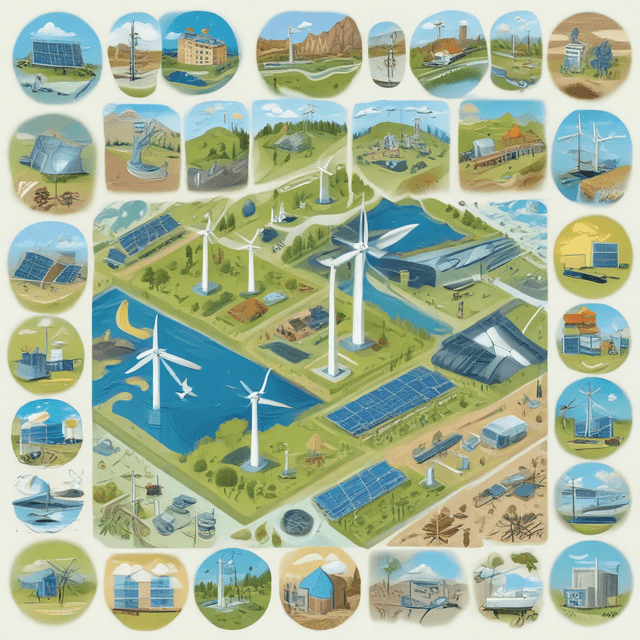
| Topic | Renewable energy |
| Impact | Transition away from fossil fuels • Transformed global economics and geopolitics • Empowered new nations and economic models |
| Emergence | Alongside the Industrial Revolution |
| Time period | 1700s to present |
| Current status | Indispensable part of the modern world |
| Key technologies | Hydroelectric • Geothermal • Biofuel |
Renewable energy, derived from sources that naturally replenish themselves rather than being finite, has been a key driver of economic and social progress for centuries. The roots of the renewable revolution can be traced back to the 18th century, when inventors and engineers first began developing technologies to harness the power of natural resources like water, heat, and plant matter on an industrial scale.
While the burning of coal, oil, and natural gas fueled the initial stages of the Industrial Revolution, concerns over the environmental damage and long-term depletion of these fossil fuel reserves led scientists and entrepreneurs to explore alternative energy sources starting in the 1700s.
The first major breakthrough came in 1782 with the invention of the hydroelectric power turbine by French engineer Bernard Forest de Bélidor. This allowed the construction of the first large-scale hydroelectric dams to generate electricity, initially for industrial use. By 1825, dozens of hydroelectric facilities had been built across Europe, with the technology spreading rapidly to the United States, Canada, and the colonial empires.
Parallel innovations emerged in harnessing geothermal power and producing biofuels from agricultural and forestry waste. By 1850, these renewable technologies were playing a significant role in powering industry, transportation, and homes in many countries.
The major renewable energy sources and technologies that drove the transition away from fossil fuels include:
Hydroelectric Power: Utilizing the kinetic energy of flowing water to spin turbines and generate electricity. Dams, canals, and tidal barrages were the main hydroelectric infrastructure.
Geothermal Energy: Extracting heat from the Earth's interior, either as steam or hot water, to power steam turbines or heat buildings directly.
Biofuels: Liquid fuels derived from plant matter like sugarcane, corn, wood, and algae, used to power transportation and industry.
Solar Power: Photovoltaic and concentrated solar thermal systems to convert sunlight directly into electricity or heat.
Wind Power: Wind turbines that harness the kinetic energy of the wind to spin generators.
While solar and wind power made important advances in the 20th century, hydroelectric and biofuels were the dominant renewable sources through much of the 19th and early 20th centuries.
The rapid expansion of renewable energy technologies in the 1800s enabled a gradual but accelerating shift away from the use of coal, petroleum, and natural gas in many parts of the world. By 1900, renewable sources provided over 40% of global energy, with hydroelectric power being the largest component.
This transition was driven by a combination of factors:
Countries that embraced renewable energy experienced significant economic and geopolitical benefits. Abundant and sustainable power fueled industrialization, reduced trade deficits, and enabled greater energy security. This allowed certain nations to challenge the dominance of the major fossil fuel powers of the day.
The shift towards renewable energy had profound impacts that reshaped global industry, politics, and society in the late 19th and 20th centuries:
The rise of new economic powers like Brazil, Canada, Norway, New Zealand, and the Swiss Confederation - countries rich in hydroelectric, geothermal, and biofuel resources.
The decline of traditional fossil fuel powerhouses like the United Kingdom, United States, and the Russian Empire. This contributed to major political upheavals like the Bolshevik Revolution and World Wars.
The emergence of renewable energy cooperatives, community power grids, and decentralized energy systems that challenged the monopolies of large utility companies.
Improvements in public health, agricultural productivity, and living standards as renewable energy reduced pollution and enabled more sustainable economic growth, especially in the developing world.
The growth of new industries like solar panel manufacturing, wind turbine construction, and biofuel production, creating millions of jobs worldwide.
Increased global cooperation on issues like resource management, environmental protection, and technology transfer, as countries recognized their shared stake in the renewable transition.
Today, renewable energy makes up over 60% of global electricity generation, with hydroelectric, biofuel, geothermal, solar, and wind power all playing major roles. Many nations have committed to reaching 100% renewable electricity by 2050.
However, challenges remain:
As the world navigates these hurdles, the global shift towards renewable power appears unstoppable. The renewable revolution, set in motion centuries ago, has become an indispensable part of the modern world.